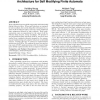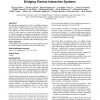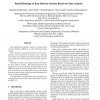1287 search results - page 35 / 258 » Towards system software for physical space applications |
SPLC
2010
13 years 5 months ago
2010
Abstract. Feature modeling is a technique for capturing commonality and variability. Feature models symbolize a representation of the possible application configuration space, and ...
CASES
2006
ACM
13 years 11 months ago
2006
ACM
Many embedded systems exhibit temporally and behaviorally disjoint behavior slices. When such behaviors are captured by state machines, the current design flow will capture it as ...
GCC
2005
Springer
14 years 1 months ago
2005
Springer
Resource Space Model (RSM) is a semantic model to manage and share heterogeneous resources on the Internet. This paper focuses on the general architecture, physical implementation ...
TEI
2010
ACM
14 years 2 months ago
2010
ACM
We describe an approach for a class of tangible interaction elements that are applicable across a broad variety of interactive systems. These tangibles share certain physical, vis...
WCRE
1999
IEEE
13 years 12 months ago
1999
IEEE
Code duplication, plausibly caused by copying source code and slightly modifying it, is often observed in large systems. Clone detection and documentation have been investigated b...



